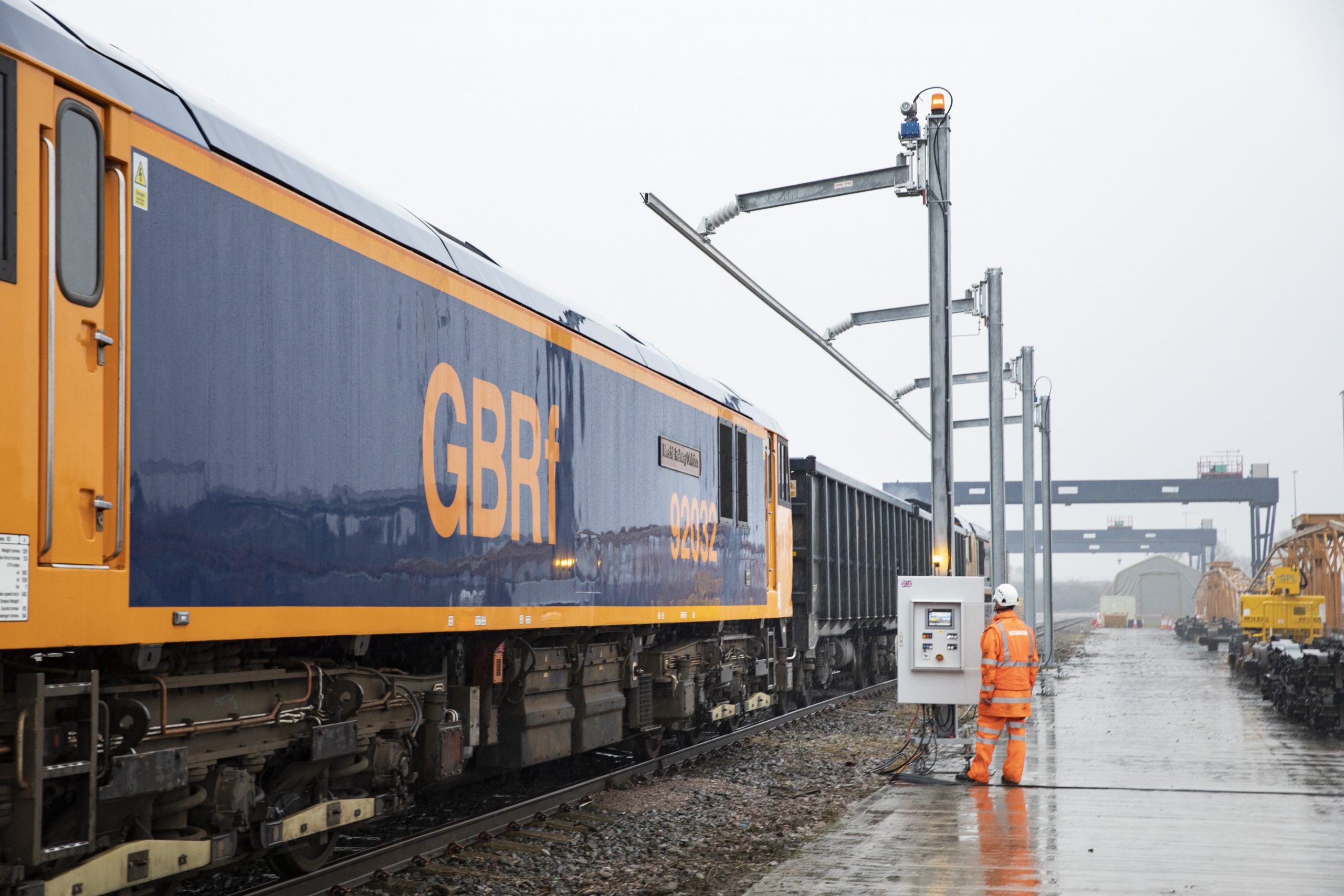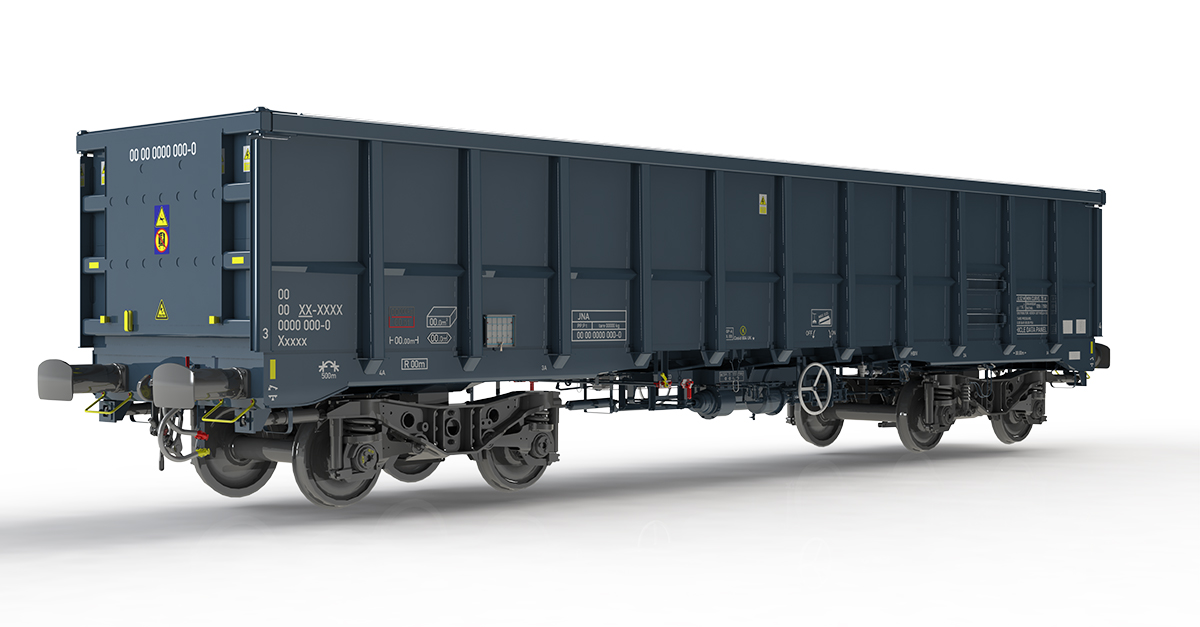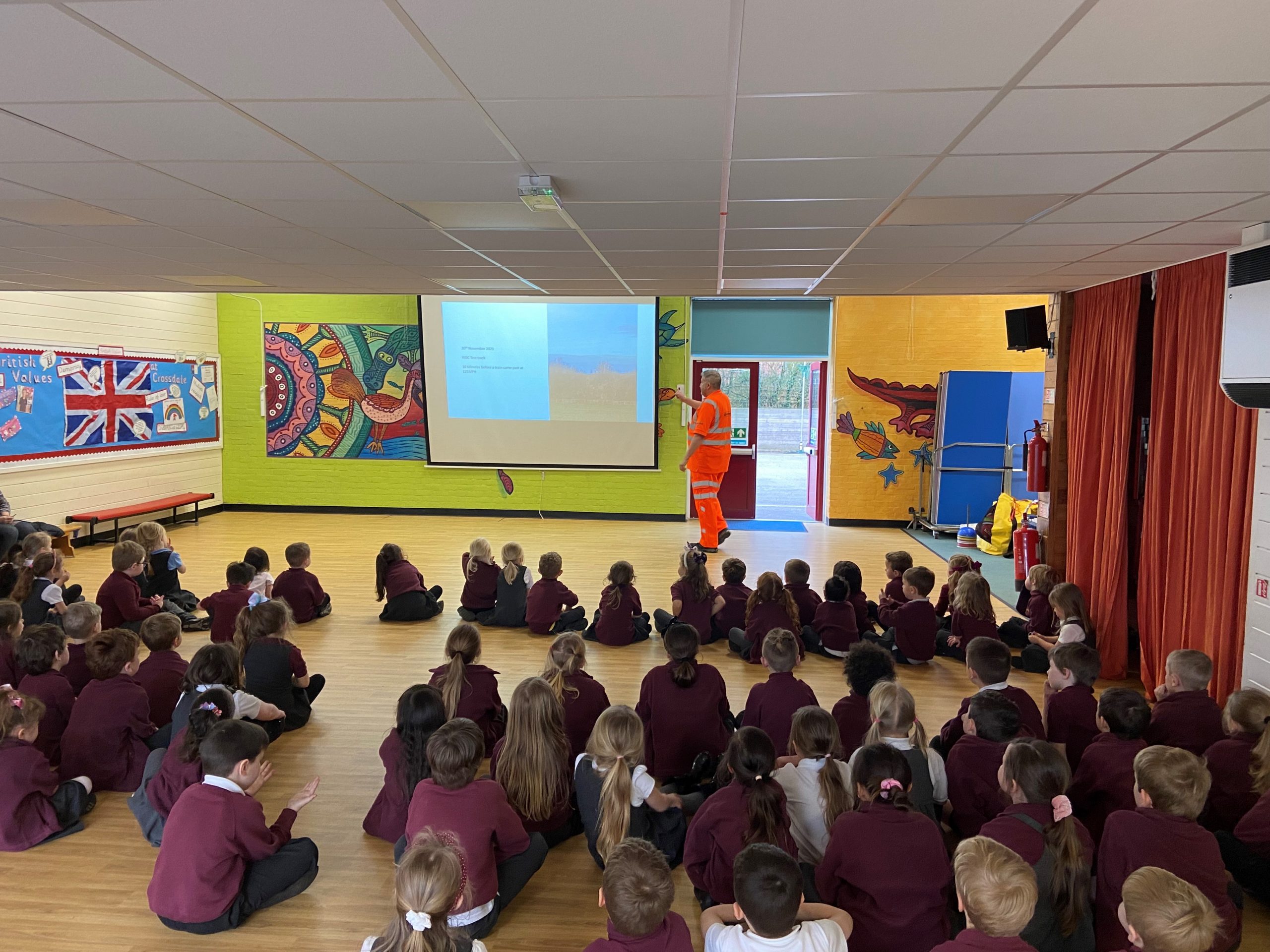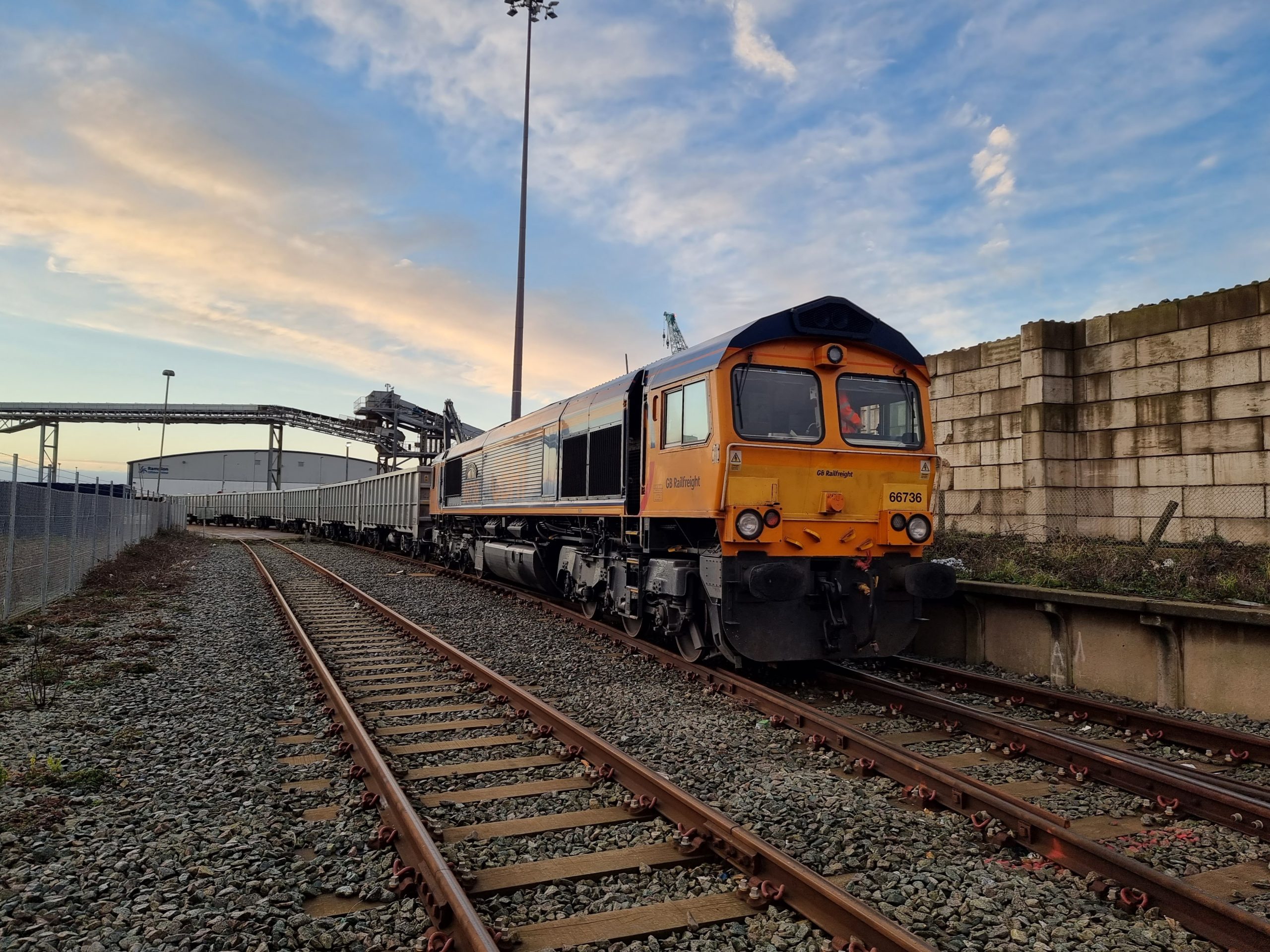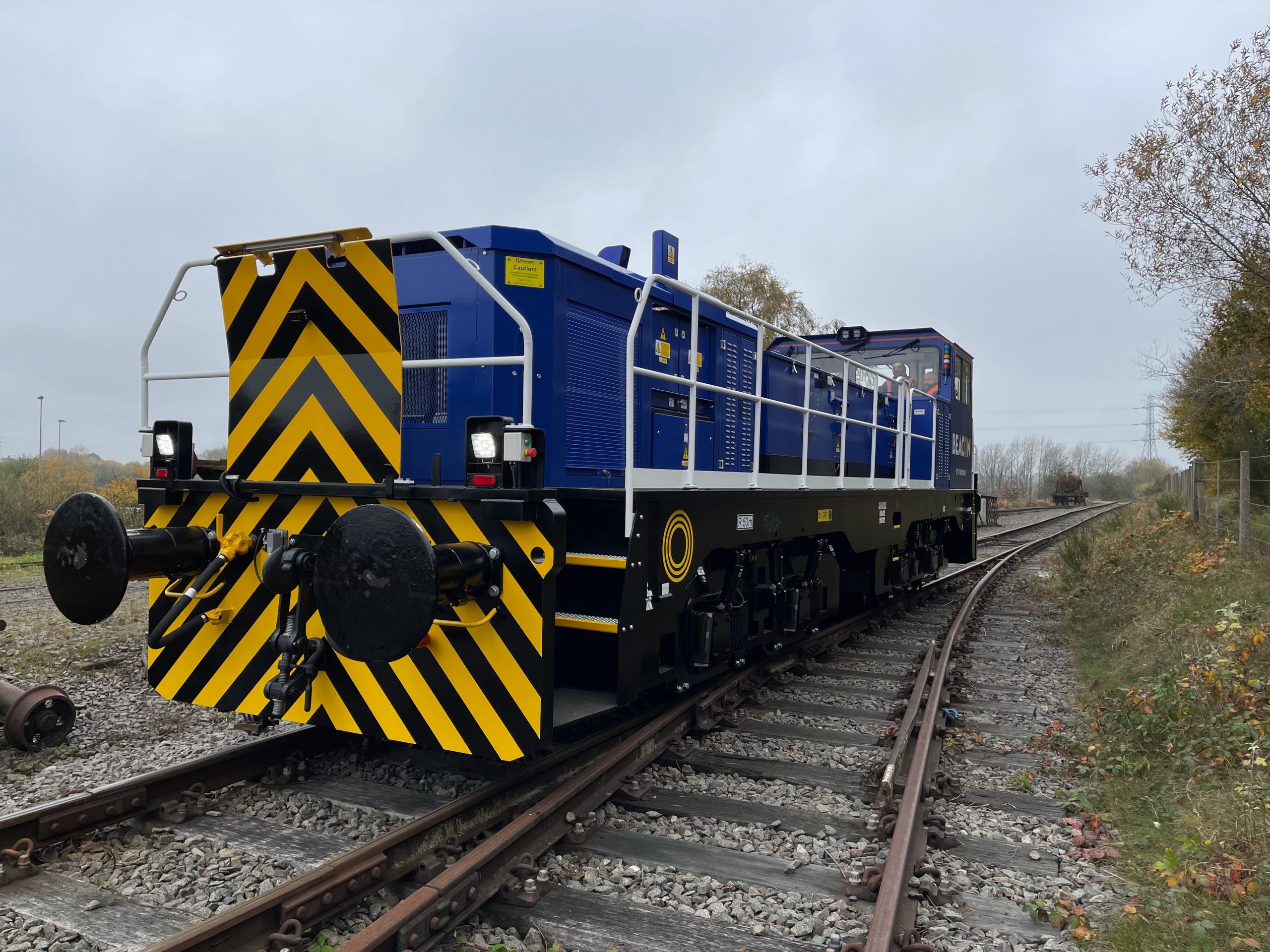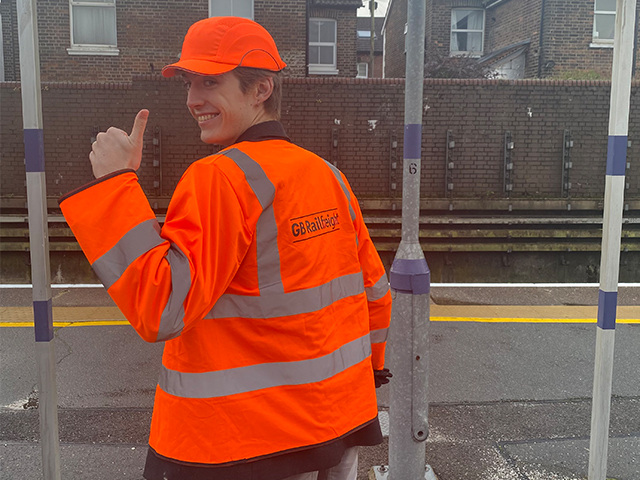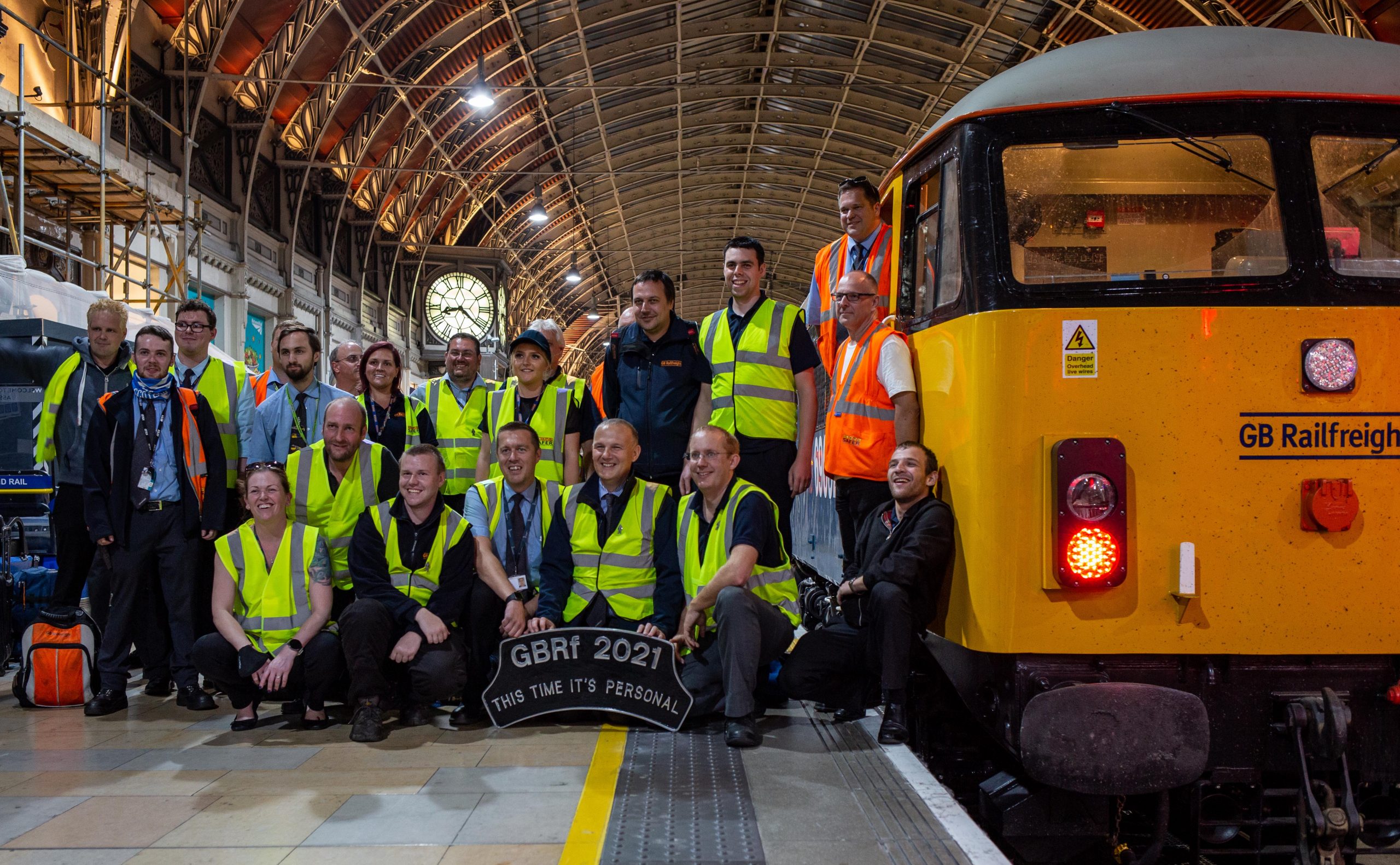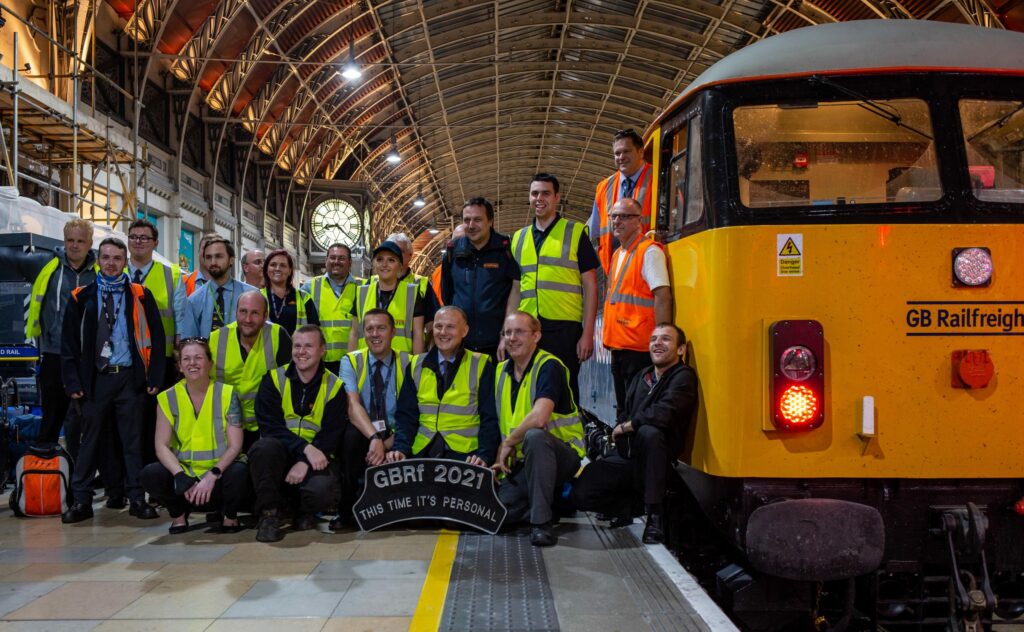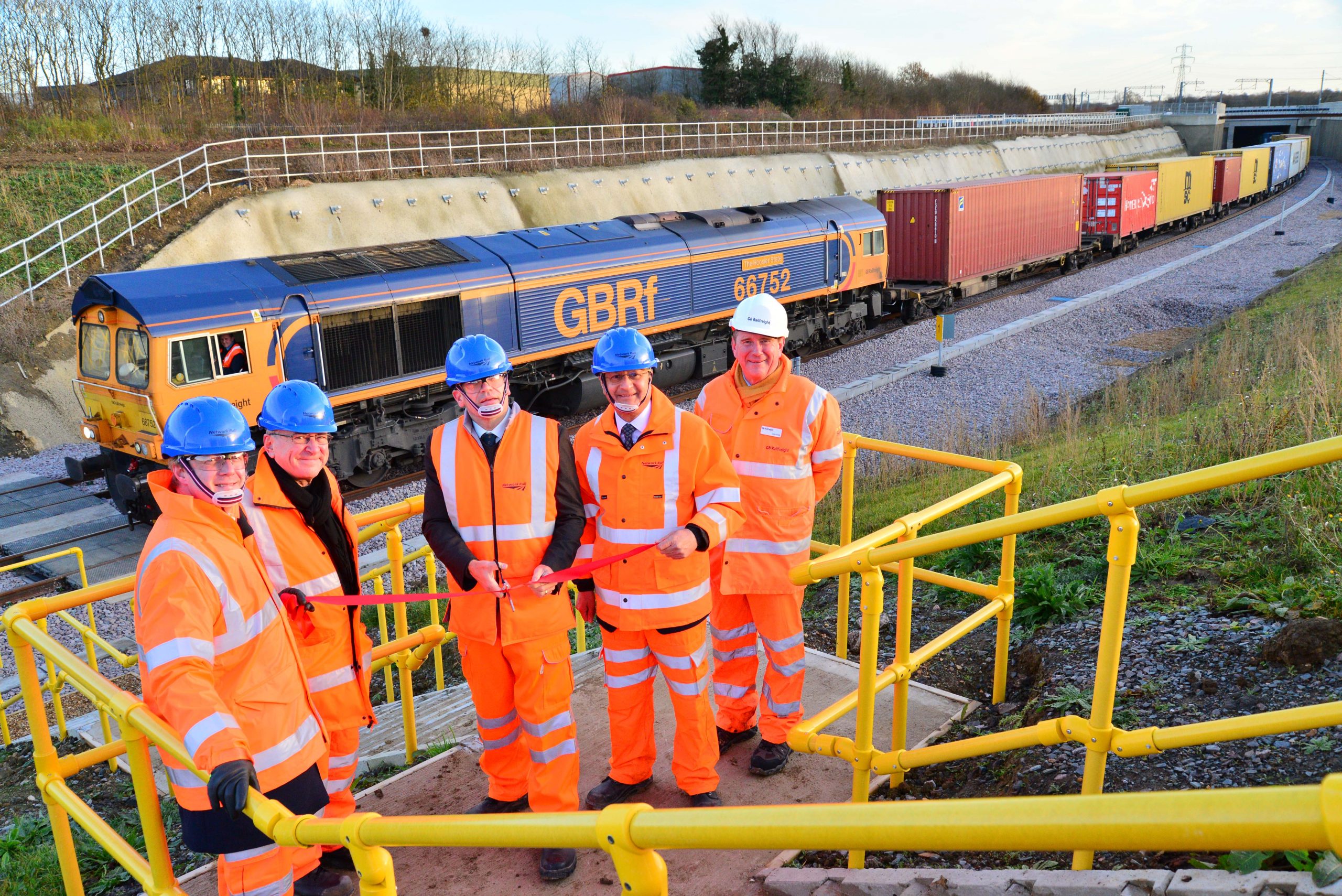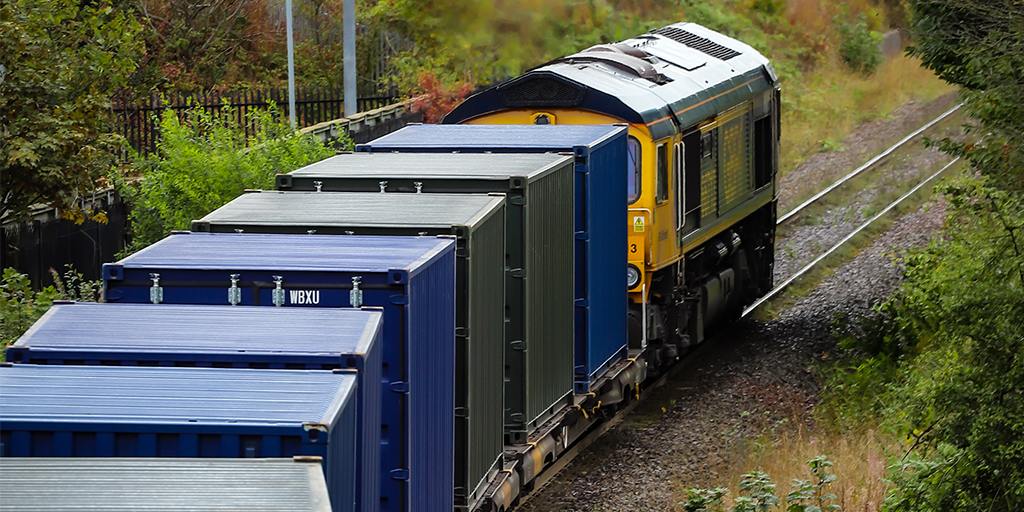Author: sam.batey@gbrailfreight.com
UK first rail freight electrification trial boosts industry net zero ambitions
-
UK first electrification system for rail freight terminals supports path to net zero rail
-
Roll-in roll-out electric freight trains could reduce delays to passenger services
-
Innovative moveable system overcomes conflict between loading freight trains and overhead electrical equipment
A rail freight terminal in Northamptonshire has become the first in the UK to demonstrate an innovative overhead electrification system, which could spell the end for diesel on electrified rail routes and boost the industry’s net zero ambitions.
The Decarbonisation & Electrification of Freight Terminals (DEFT) project, funded by the Department for Transport and Innovate UK, has seen project partners Furrer+Frey GB, Tarmac and GB Railfreight demonstrate a new way of decarbonising rail and lessen freight’s impact on passenger journeys.
Freight trains are typically loaded and unloaded from above, preventing the use of the high voltage overhead cables used on mainline railways. As such, they still rely on diesel to move in and out of terminals and passengers can be held up by slower diesel freight trains on mainlines, or those waiting to be moved into a depot by a shunter.
Engineers from Furrer+Frey GB designed a Moveable Overhead Conductor system where overhead equipment supplying electricity to the locomotives can safely move away once the train is in place and return when the train needs to move again.
Furrer+Frey’s innovative system is being trialled at an aggregate facility – run by one of world’s leading construction materials businesses, Tarmac – in Wellingborough, in partnership with GB Railfreight.
The facility is adjacent to the Midland Mainline, which is currently being electrified and upgraded by Network Rail as part of the Government’s Integrated Rail Plan, to increase capacity for passengers and freight trains.
If successful, the moveable overhead system could go on to be deployed at other freight terminals across the UK and support the full decarbonisation of Britain’s railways.
Rail Minister Wendy Morton said:
“It is fantastic to see winners of our First Of A Kind competition getting out there and helping transform the railways for the better.
“Making rail freight even more environmentally friendly helps us leap forward in our plans to build back greener and make the whole UK net zero by 2050.”
Noel Dolphin, Head of UK projects at Furrer+Frey GB, said:
“The electrification of freight terminals is the biggest technological hurdle to net zero rail freight and we have just overcome it. The demonstrator shows how we can plug freight yards into electrified rail lines and operate them safely and efficiently with the locomotives we already have – meaning greener, cleaner and better journeys.
“This moveable conductor system means trains pull in on electricity, disconnect from it to safely load and unload, then reconnect to travel on.
“I’m proud of our team and partners for getting us to this milestone moment today showing a greener future for the industry.”
Chris Swan, head of rail at Tarmac, said:
“Decarbonising transport has been highlighted as one of the key areas in which we can help achieve net zero across the construction industry.
“Supporting this exciting project is just the latest step in the ongoing development of our rail freight capabilities, which forms part of Tarmac’s wider commitment to reducing CO2 across the whole business.
“We’re always keen to explore new initiatives and innovations that can help us move materials to the right place at the right time more efficiently and sustainably.”
John Smith, CEO GB Railfreight, said:
“Rail freight is already a greener alternative to moving goods by road but innovations like the Moveable Overhead Conductor System, and electrification more broadly, will allow us to go even further.
“At the same time as combatting climate change, they also bolster operations, and the reliability and efficiency of rail freight.
“We continue to work with the UK government to fulfil our industry’s potential and this is a great example of what can be achieved when the industry and government work together effectively.”
Rail freight is already much greener than moving goods by road. Lorries emit nine times the emissions of rail freight per tonne kilometre. Shifting goods from roads to the railways is an important pillar of the Government’s Transport Decarbonisation Plan.
Seamless electrification for freight could begin to see slower, more polluting diesel trains being phased out. In 2018 the Government challenged the rail industry to remove all diesel-only trains from the network by 2040 as part of a drive to achieving the UK’s ambitious net zero goals, as well as to help improve air quality and reduce noise pollution.
The system being trialled in Northamptonshire is based on one developed by Furrer+Frey for passenger train depots, used by Eurostar and LNER, and has been installed by SPL Powerlines.
The DEFT project is one of 30 groundbreaking initiatives that have won a share of £9 million from the Department for Transport, in partnership with Innovate UK. The competition is focused on developing pioneering technology and exceptional ideas that can improve journeys for travellers, encourage passengers back onto the network and reduce the environmental impacts of rail as the country builds back better from Covid-19.
The DEFT concept was endorsed by members of the Rail Forum Midlands in 2020 as a viable method to decarbonise UK rail freight, leading to the successful funding bid to InnovateUK and the Department for Transport.
Tarmac is among the largest users of rail freight, transporting construction materials by rail UK-wide as part of the business’ ongoing sustainability commitments.
GB Railfreight and Porterbrook partner to build 50 new wagons for sustainable rail freight growth
GB Railfreight (GBRf) and rolling stock company Porterbrook are today (15th March) announcing the production of 50 new Greenbrier box wagons, building on their 15-year relationship as part of a sharp growth in rail freight demand.
The transaction marks a renewed commitment from the companies to developing sustainable freight transport to meet the significant expected growth in the sector. Recent research by IPEX on the UK market, commissioned by Porterbrook, cited projections that intermodal rail freight is forecast to grow by over 10%, between 2022 and 2034 while construction sector traffic is expected to increase by up to 35% over the same period.
David Golding, Asset Director at GB Railfreight, said:
“By partnering with Porterbrook, the new rolling stock marks our commitment to supporting sustainability in the construction sector. As we look towards the future, this investment will help meet growing demand for rail freight services, whilst playing a key role in the delivery of Government’s net zero targets.”
The partnership between GB Railfreight, Porterbrook and Greenbrier builds on rail’s strong environmental credentials. It also supports the government’s wider transport decarbonisation plans by encouraging a modal shift in the transportation of goods from road to rail.
Mark Wyborn, Head of Freight at Porterbrook said:
“Today’s announcement strengthens Porterbrook’s long-term commitment to investing in rail freight and the tangible benefits this will bring not only to the economy, but to the UK’s green recovery.”
“We are thrilled that GB Railfreight has chosen to extend its partnership with Porterbrook and support us in our ambitions to bring green, innovative and affordable rolling stock options to the UK supply chain.”
GB Railfreight educate Nottinghamshire school children about rail safety
On Thursday 3 February, children from Crossdale School, in Keyworth, Nottinghamshire, received presentations from GB Railfreight’s (GBRf) safety team about the dangers of the railway.
Rod Storer, Depot Safety Manager, and Chris Parsons, SHEQ Manager, from Rail Innovation and Development Centre (RIDC) Melton, based in Melton Mowbray, Leicestershire, led a series of presentations adapted to suit the school’s Key Stage 1 and 2 students.
As part of an initiative to educate local communities about its operation at RIDC Melton, the sessions were based on the dedicated train testing facility, and its electrified high and low speed test tracks.
GBRf has already delivered safety talks to Asfordby Hill School, in Leicestershire, and plans to visit more schools in the East Midlands area.
Rod Storer, Depot Safety Manager, GB Railfreight, said:
“RIDC Melton can be extremely dangerous if people do not understand the risks associated with an electrified test track. We are committed to educating communities local to our operation, especially children, to ensure they are aware of the dangers that exist.
“We hope the children of Crossdale school not only found the sessions engaging and informative, but have taken on the serious message that the railway is not a playground and ignoring important rules can result in life-changing consequences.”
GB Railfreight launch new service for Brett Aggregates
GB Railfreight (GBRf) and Brett Aggregates, independent building materials supplier, successfully launched a new aggregates service from Newhaven, East Sussex, to Thorney Mill, West Drayton, on Wednesday 19 January.
This was the first service operated by GBRf from Brett Aggregates’ Newhaven collection terminal, which is capable of receiving 10,000t cargo vessels. The train consisted of 17 wagons, transporting approximately 1,350 tonnes of aggregate destined for construction projects in South East, England.
The new service marks GBRf’s continued expansion in the Bulk market and brings opportunity to support Brett Aggregates by operating future services from its collection terminals.
Tim Hartley, Business Development Director, GB Railfreight, said:
“This new service demonstrates how transporting material by rail, which otherwise would have been taken by road, significantly reduces the environmental impact of important construction projects across the South East.”
GB Railfreight boosts sustainability by trialling new battery powered locomotive
GB Railfreight (GBRf) has taken delivery of a Class 18 hybrid+ shunting locomotive as part of a three-month trial with Beacon Rail Leasing, marking the latest expansion of its growing fleet.
As GBRf looks towards the future of its assets, the shunting locomotive will enable low noise and zero emissions, demonstrating a clear contribution to the challenge of meeting the UK’s net zero carbon targets.
The locomotive was delivered to Whitemoor on Tuesday 1 February, where it will undergo a series of testing to understand its capabilities and performance.
Manufactured by Clayton Equipment Ltd, the Class 18 is powered by an onboard battery that provides emissions-free operation where charging facilities are available, or through a regenerative braking system. When challenges with range or operation occur, an efficient onboard Stage V compliant engine can be utilised to increase the locomotives running time.
David Golding, Asset Director, GB Railfreight, said:
“The Class 18 hybrid+ shunting locomotive has the power to play a key role in the decarbonisation of our future fleet. Going forward, it will offer a wide range of sustainable benefits capable of significantly reducing the environmental impact of our operations.”
Rob Dee, Chief Commercial Officer, Beacon, said:
“We are very pleased to have delivered the first of our order of 15 Class 18 hybrid+ shunting locomotives, from Clayton Equipment, to GB Railfreight. This is a key milestone in our delivery program and we look forward to working with GB Railfreight through their trial period. This locomotive will offer our customers a greener and sustainable option for railfreight operations in the UK against the backdrop of targets to reduce emissions,”.
Clive Hannaford, Managing Director, Clayton Equipment, said:
“We are very proud to supply GB Railfreight through Beacon Rail with the Class 18 locomotive. In the fast-changing environment with decarbonisation targets, the increased demand for lower emissions, new technology and more capacity, the Clayton Equipment Hybrid+ CBD90 will support GBRf with sustainable environmental benefits which meets their commitment to invest in new technology and provide real cost savings”.
Francis Bourgeois, TikTok star, announced as GB Railfreight brand ambassador
GB Railfreight (GBRf) is excited to announce TikTok trainspotting star Francis Bourgeois as its new brand ambassador. Throughout 2022, Francis will be sharing his passion and insights for the railway, by showcasing the vital role of rail freight and going behind the scenes at GBRf.
Francis first came to GBRf’s attention following his famous video featuring the Class 73/9 locomotive named ‘Dick Mabbutt’, which has now amassed 12 million views on TikTok. Since becoming a platform favourite for his enthusiastic trainspotting videos across the rail network, Francis has amassed over 2 million followers on TikTok and over 1 million followers on Instagram. This popularity has earned him appearances on ITV’s ‘This Morning’ and collaborations with big names such as Thierry Henry and ASOS.
Seema Kotecha, Head of Communications & Marketing, GB Railfreight, said:
“Francis is the perfect brand ambassador for raising the profile of rail freight and the important work our industry does to support the UK Economy and efforts to reach net zero. We have all loved his content and infectious energy that has put a spotlight on the railway.”
Francis Bourgeois, GB Railfreight brand ambassador, said:
“I am so excited to be joining GB Railfreight, I have had a lifelong passion for the railway, and I can’t wait to apply this enthusiasm to my ambassadorship at the company. I am really looking forward to elevating the world of trains, rail freight, and spreading happiness and joy in general — with GB Railfreight, we will be able to achieve this together.”
GB Railfreight charity railtour raises over £147,000 for Prostate Cancer UK
GB Railfreight (GBRf) has raised more than £147,000 for its charity partner, Prostate Cancer UK, following the success of its charity railtour, ‘GBRf 2021’.
Having departed London Victoria on Thursday 2 September 2021, the four-day charity charter travelled across different parts of the UK rail network, finishing at London Paddington on Sunday 5 September 2021.
Organised by GBRf’s charity railtour team, Paul Taylor, Ian Grey and Dale Williams, ‘GBRf 2021’ was the company’s third 4-day railtour, having raised over a quarter of a million pounds from its previous two marathon charity charters.
The success of this railtour was underpinned by the support of the wider rail industry and 50 volunteers from within GBRf who gave up their own time to work as train drivers and stewards.
In total, ‘GBRf 2021’ raised £147,215, which will go towards supporting Prostate Cancer UK’s mission to stop the disease limiting lives.
Prostate cancer is the most common cancer in men, with one in eight men affected by the disease. This year, GBRf unveiled a specially painted locomotive featuring the charity’s iconic ‘Man of Men’ logo, sparking conversations aplenty about the disease. Funds raised will go into lifesaving research to make prostate cancer a disease men and their families no longer fear.
John Smith, CEO GB Railfreight, said:
“Yet again, our team have delivered another highly successful railtour that has raised an amazing amount for our chosen charity partner, Prostate Cancer UK. More now than ever, funds are needed to support vital research into better tests and treatments for people affected by prostate cancer and we’re proud to contribute to this great cause.
“My thanks go to our charity railtour team and the GBRf volunteers who gave up their own time to make this fundraising feat possible and provide much needed assistance behind the scenes.”
Paul Taylor, Contract Manager GB Railfreight, said:
“I’m amazed at what we’ve achieved as a team to raise over £147,000 for Prostate Cancer UK, a charity very close to my heart following my diagnosis with the disease a few years ago. The crucial funds raised by this railtour will help in the fight against prostate cancer, which is credit to the huge contribution made by our team of volunteers and support shown by the railway family.”
Nicola Tallett, Director of Fundraising & Supporter Engagement Prostate Cancer UK, said:
“We’re delighted and hugely grateful to be on this lifesaving journey with GB Railfreight, and are thrilled to learn that more than £147,000 has been raised from the brilliant railtour and other fundraising activity. That amazing sum will help fund lifesaving research into the most common cancer in men as we go full steam ahead to do vital research into better tests and treatments. It’s also allowed us to continue to have hugely important conversations about prostate cancer – a disease affecting one in eight men in the UK, and one in four black men.
“We’re so thankful for the tireless support of John Smith and Paul and Tracy Taylor, who were huge driving forces in this project after Paul’s diagnosis with prostate cancer. On behalf of Prostate Cancer UK and all the men and families affected by this disease we thank everyone for getting on board.”
Werrington Tunnel opens unlocking faster journeys on the East Coast Main Line
New rail freight tunnel brings significant improvements to passenger journeys as part of the East Coast upgrade.
- ground-breaking new tunnel dives under East Coast Main Line unlocking faster, more frequent and reliable journeys
- UK engineering first as 11,000-tonne curved concrete tunnel installed in one go
- opening is a major leap forward for the £1.2 billion East Coast upgrade, which will provide more seats and enable quicker journeys between London, the north of England and Scotland
Rail Minister Chris Heaton-Harris has today (9 December 2021) officially opened the brand-new Werrington Tunnel which carries freight trains underneath the busy East Coast Main Line and ensures that passenger services will no longer be disrupted by freight trains crossing the tracks.
The tunnel will bring significant improvements to passenger journeys on the East Coast Main Line as it passes through Peterborough. By easing congestion on existing tracks, the project will unlock the potential to shave time off journeys, allow more passenger trains through, and will see improved reliability for journeys using the line daily.
This is another successful step in the £1.2 billion East Coast upgrade, which will provide more seats and enable quicker journeys between London, the north of England and Scotland.
The completed project will help pave the way for the massive infrastructure roll out across the north and Midlands recently announced in the Integrated rail plan (IRP). The IRP sets out £96 billion worth of investment into the railways that will deliver real and meaningful improvements to communities, supporting economic growth by transforming both east–west and north–south links. The IRP will bring benefits more quickly to more places, many of which would have gained little under previous plans.
Rail Minister, Chris Heaton-Harris said:
“This country’s railways have long been home to marvels of engineering and the new Werrington Tunnel shows that we are continuing that proud tradition.
Opening this new section of railway marks the end of a project which saw Network Rail engineers deliver an incredible feat installing an 11,000-tonne concrete tunnel, freeing up tracks and unlocking new opportunities for rail freight.
Our investment in the railways, including the unprecedented £96 billion we are spending through the integrated rail plan, means there are even more opportunities to move goods by rails, taking HGVs off the road.”
The engineering needed to install the tunnel saw a UK-first, as the 11,000-tonne curved concrete tunnel, 1,000 tonnes heavier than the Eiffel Tower, was slid into place under the existing railway in January this year. The ‘curved box’ was built next to the East Coast Main Line in 9, interconnected sections. The structure is 155 metres long, 9.5 metres wide and 5.1 metres high, with 1 metre thick walls.
In July, the new track installed inside the tunnel was connected to the existing lines. Work continued to install the signalling system which was commissioned over a single weekend in September. Vital testing of the new tunnel then took place to enable trains to start using the infrastructure.
Rob McIntosh, Managing Director for Network Rail’s Eastern region, said:
“From building the huge concrete tunnel onsite next to the East Coast Main Line, to pushing it into place in a UK first for engineering, to installing new track and signalling equipment to connect it to the existing lines – it’s been amazing to see the progress our teams have made on this ground-breaking project.
Passengers travelling between London, Peterborough, the north of England and Scotland will benefit from faster, more reliable journeys as longer freight trains can now dive underneath the famous passenger route.
I’m proud of our team’s brilliant response to the challenges of the COVID-19 pandemic and how they reached major milestones on the project when it was at its peak. Using innovative methods, we’ve also been able to avoid major disruption for passengers, as services have continued running throughout the majority of the work. We want to thank passengers as well as people in the community for their continued patience.”
The reforms in the Williams-Shapps plan for rail will set up rail freight for the future, investing in projects which boost capacity, improve performance and cut carbon emissions, as the government levels up the country and builds back greener.
Rail freight offers real benefits to the economy and environment – adding £2.5 billion to the UK economy per annum, removing over 7 million lorry journeys from our roads each year and emitting a quarter of the carbon dioxide of lorries per tonne kilometre travelled.
John Smith, CEO of GB Railfreight said:
“The Werrington tunnel is a win for both consumers and the rail freight industry. It will not only improve passenger journeys, but also crucially unlock much-needed extra capacity on the network for freight services. This is an important investment by the government and furthers our industry’s efforts to create a more efficient supply chain across the UK, whilst making crucial environmental and regional investment progress at the same time.”
David Horne, Managing Director at LNER said:
“This unique project has seen huge cross-industry collaboration, with Network Rail working together with train operators and project partners to deliver this essential part of the East Coast upgrade. The completion of this project will reduce delays and create capacity to enable more LNER services to be launched in our new timetable.”
Simon Smith, Managing Director for Morgan Sindall Infrastructure, principal contractor on the project said:
“We’re incredibly proud to have worked closely with Network Rail and our supply chain to deliver the UK’s first curved portal push on the East Coast Main Line upgrade at Werrington. The portal is a great example of the UK’s leading engineering and innovation expertise, harnessing these skills to enhance passengers’ experiences between London and the north of England.”
GBRf Announce New Intermodal Service from Port of Tyne
As the country continues to struggle with supply chain issues, GB Railfreight (GBRf) are excited to share that they have successfully operated a series of intermodal services from the Port of Tyne to strategic rail hubs in Yorkshire and the Midlands.
The campaign saw GBRf operate intermodal services from Port of Tyne to Yorkshire twice-a-week in addition to services to the Midlands once-a-week.
This series of intermodal services comes as the Port of Tyne welcomes intermodal traffic to help ease the strains caused by simultaneous increased consumer demand and supply chain challenges, ensuring the delivery of goods across the UK.
John Smith, CEO of GB Railfreight, said:
“As import volume levels grow, this campaign of services demonstrates how rail freight can offer a real solution to the current issues facing our busiest deep sea ports.
“We’re proud to work with the Port of Tyne to operate this intermodal service. By unlocking extra capacity, this new flow can play a key role to ensure the timely and sustainable delivery of goods around the country.”
Richard Newton, Commercial Director – Logistics at the Port of Tyne said:
“We’re delighted to work with GBRf to enhance our service and provide another route to market, in addition to our own haulage, port centric warehouse operations and transshipment to other UK ports. This boost to our offering demonstrates our capability to provide flexible and bespoke, solutions to our customers.”

